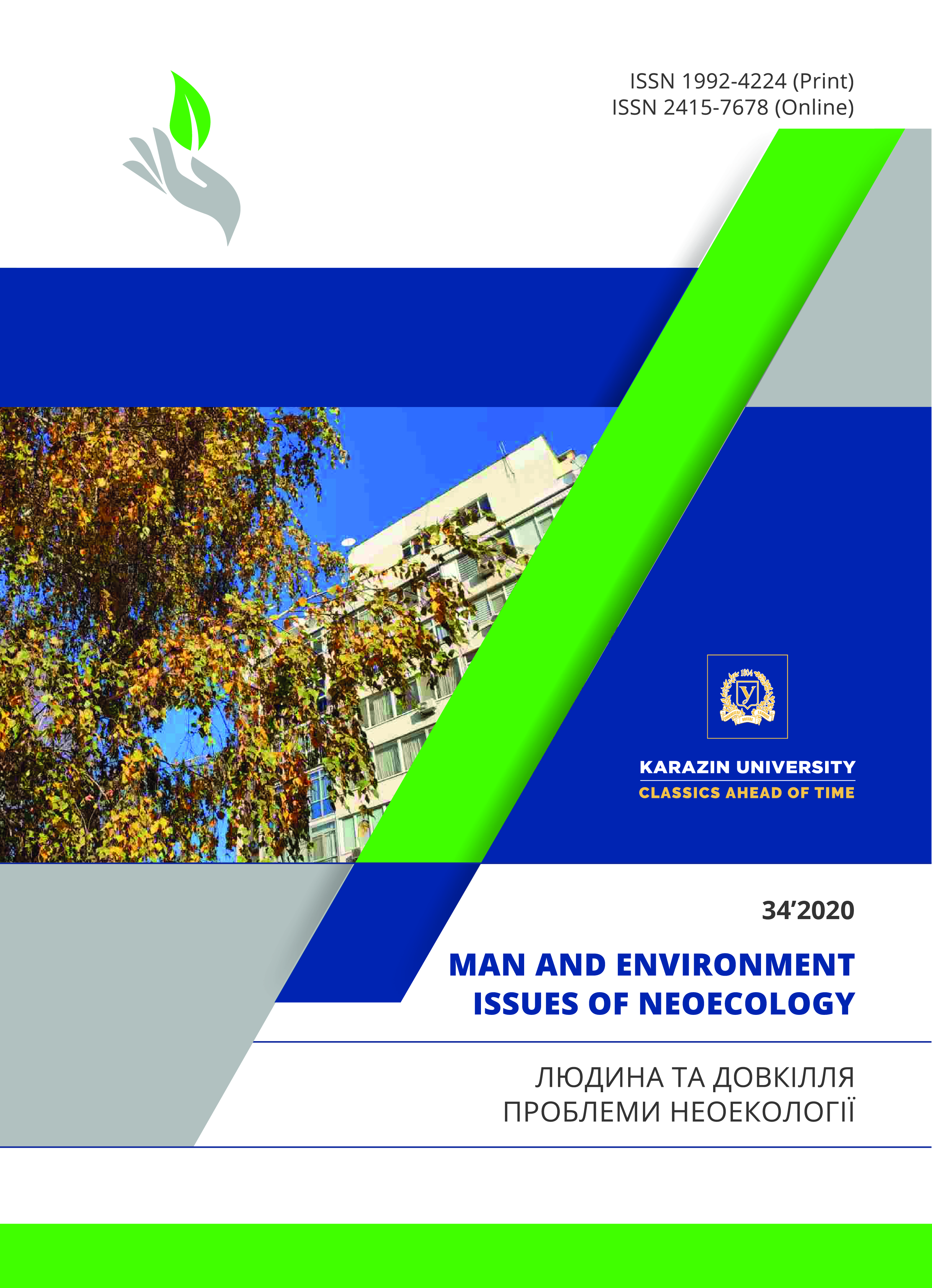On the Issue of Research of Information Support of Sustainable Agricultural Landscapes Formation
Abstract
Purpose. To characterize the methodological approaches that we develop in the formation of a system of information support for the creation and maintenance of the functioning of modern sustainable agricultural landscapes and to show the results of their implementation on the example of the territory of some agricultural enterprises of the Kharkiv region.
Methods. Cartographic, geoinformation analysis, calculation, statistical and mathematical.
Results. Some results of the work of the collective on the issues of information support for the creation and maintenance of the functioning of modern sustainable agricultural landscapes. Namely, verification of erosion models, studies of the functionality of shelter belts, the formation of an agroeconet (an extensive network of natural and quasi-natural landscapes) on agricultural land massifs, which ensures the maintenance of stable functioning of meso and macrolevel agrolandscapes, as well as the experience of using magnetic prospecting methods to verify the results of mathematical modeling of erosion processes.
Conclusions. A number of methodological approaches to information support of the formation of sustainable agricultural landscapes in the natural and socio-economic conditions of Ukraine have been developed. They relate to the functioning of anti-erosion measures of permanent action, the processes of modern transformation of agro-landscapes, the ecological impact of erosion processes on the environment. The connection between the length of forest belts per unit of arable land and soil erosion is shown. A methodical approach has been developed to estimate the amount of soil washed away from arable land and to calculate the measures necessary to eliminate its harmful effects on the environment.
Downloads
References
Baliuk, S. A., Medvediev, V. V., Vorotyntseva, L. I. & Shymel V. V. (2017). Productivity of grain of early hybrids of corn of different strain changings. Bulletin of Agrarian Science, 8, 5–11. Retrieved from https://doi.org/10.31073/agrovisnyk201708-01
Balyuk, S. A. & Tovazhnyansky, L. L. (Eds.). (2010). Scientific and applied bases of soil protection from erosion in Ukraine. Kharkiv: NTU "KPI". (In Ukranian).
Bulygin, S.Yu. (2005). Formation of ecologically sustainable agrolandscapes. Kyiv: Urozhay. (In Ukranian).
Morgan, R. P. S., Quinton, J. N., Smith, R. E. Govers, G., Poesen, J.W.A., Auerswald, K., Chisci, G., Torri, D., Styczen, M.E. & Folly, A.J.V. (1998). The European Soil Erosion Model (EUROSEM): documenta-tion and user quide. Version 3.6. Silsoe College Cranfild Universety, Silsoe, United Kingdom. Re-trieved from https://eprints.lancs.ac.uk/id/eprint/13189/1/user_v2.pdf
Flanagan, D. C., Gilley, J. E. & Franti, T. G. (2007). Water erosion prediction project (WEPP): development history, model capabilities, and future enhancements. Transactions of the American Society of Agricultural and Biological Engineers, 50(5), 1603-1612. Retrieved from https://www.ars.usda.gov/ARSUserFiles/50201000/WEPP/weppHistory.pdf
Larionov, G. A., Dobrovolskaya, N. G., Krasnov, S. F. & Liu B. Yu. (2003). New equation of the relief factor for statistical models of water erosion. Soil Science, 10, 1239 - 1247. Retrieved from https://www.elibrary.ru/item.asp?id=17288927 (In Russian).
Toth, G., Montanarella, L. & Russo, E. (2008). Treats to soil quality in Europe. Luxembourg: Office for official publications of the European communities. Retrieved from https://esdac.jrc.ec.europa.eu/ESDB_Archive/eusoils_docs/other/EUR23438.pdf
Bulygin S.Y., Nearing M.A. & Achasov A.B. (2002). Parameters of interrill erodibility in the WEPP model. Eurasian Soil Science, 35 (11) 1237 Retrieved from https://pubag.nal.usda.gov/download/7826/PDF
Alewell, C., Borrelli, P., Meusburger, K. & Panagos P. (2019). Using the USLE: Chances, challenges and limitations of soil erosion modeling. International Soil and Water Conservation Research, 7 (3). 203-225. Retrieved from https://doi.org/10.1016/j.iswcr.2019.05.004
Kutsenko, M.V. & Kruglov, O.V. (2010). About creation of the automated system of geoinformation support of the universal equation of expenses of soil (USLE). Geoinformatics, 4, 85-89. Retrieved from http://nbuv.gov.ua/UJRN/geoinf_2010_4_12 (In Ukranian).
World Bank. (2006). Sustainable Land Management: Challenges, Opportunities, and Trade-offs. Agriculture and Rural Development. Washington, DC: Wolrd Bank. Retrieved from http://hdl.handle.net/10986/7132
Belolipskyi, V. & Poluliakh, М. (2020). Application of the basin concept for soil and water protection arrangement of agro landscapes. Bulletin of Agrarian Science, 98 (6) 55-66. Retrieved from https://doi.org/10.31073/agrovisnyk202006-07 (In Ukranian).
Bondarev, V.P. (1996). Influence of neotectonics on the distribution of the ravine network of the Central Chernozem Region Vestnik of Moscow University. Geography, 5 (4), 41-45.
Kruglov, O.V., Timchenko, D.O., Nazarok, P.G. & Lizogubov V.O. (2015). System of geoinformation and technological support of measures for protection of soils from erosion taking into account regional features: scientific and methodical manual. Kharkiv. Aladdin-Print. (In Ukranian).
Shevchenko, M.V., Kolyada, V.P., Kruglov, O.V. & Demkin, O.O. (2016). Spatial distribution of soil erosion factors in the Kharkiv region. Bulletin of KhNAU. Crop production, selection and seed production, fruit and vegetable growing and storage, 2, 165–176. Retrieved from http://dspace.knau.kharkov.ua/jspui/handle/123456789/868(In Ukranian).
Kolyada, V.P., Shevchenko, M.V., Kruhlov, O.V., Achasova, A.O., Nazarok, P. G. & Hrebenchuk, O.O. (2018). Anti-erosion optimization of agricultural equipment: local level. Man and environment. Issues of neoecology, (1-2), 57-63. Retrieved from http://journals.uran.ua/ludina_dov/article/view/143819 (In Ukranian).
Communication from the commission to the European Parliament, the Council, the European economic and social committee and the Committee of the regions EU biodiversity strategy for 2030. Bringing na-ture back into our lives. com/2020/380 final Brussels, 20.5.2020 Retrieved from https://eur-lex.europa.eu/legal-content/EN/TXT/?qid=1590574123338&uri=CELEX:52020DC0380
Nazarok, P.G., Kruglov, O.V., Kutsenko, M.V., Menshov, O.I. & Sukhorada, A.V. (2015). To the problem of mapping erosion processes. Bulletin of Agricultural Science, 9, 63-68. Retrieved from https://agrovisnyk.com/pdf/en_2015_09_13.pdf (In Ukranian).
Authors reserve the right of attribution for the submitted manuscript, while transferring to the Journal the right to publish the article under the Creative Commons Attribution License 4.0 International (CC BY 4.0). This license allows free distribution of the published work under the condition of proper attribution of the original authors and the initial publication source (i.e. the Journal)
Authors have the right to enter into separate agreements for additional non-exclusive distribution of the work in the form it was published in the Journal (such as publishing the article on the institutional website or as a part of a monograph), provided the original publication in this Journal is properly referenced
The Journal allows and encourages online publication of the manuscripts (such as on personal web pages), even when such a manuscript is still under editorial consideration, since it allows for a productive scientific discussion and better citation dynamics (see The Effect of Open Access).





